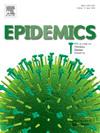Estimating the generation time for influenza transmission using household data in the United States
IF 2.4
3区 医学
Q2 INFECTIOUS DISEASES
引用次数: 0
Abstract
The generation time, representing the interval between infections in primary and secondary cases, is essential for understanding and predicting the transmission dynamics of seasonal influenza, including the real-time effective reproduction number (Rt). However, comprehensive generation time estimates for seasonal influenza, especially since the 2009 influenza pandemic, are lacking. We estimated the generation time utilizing data from a 7-site case-ascertained household study in the United States over two influenza seasons, 2021/2022 and 2022/2023. More than 200 individuals who tested positive for influenza and their household contacts were enrolled within 7 days of the first illness in the household. All participants were prospectively followed for 10 days, completing daily symptom diaries and collecting nasal swabs, which were then tested for influenza via RT-PCR. We analyzed these data by modifying a previously published Bayesian data augmentation approach that imputes infection times of cases to obtain both intrinsic (assuming no susceptible depletion) and realized (observed within household) generation times. We assessed the robustness of the generation time estimate by varying the incubation period, and generated estimates of the proportion of transmission occurring before symptomatic onset, the infectious period, and the latent period. We estimated a mean intrinsic generation time of 3.2 (95 % credible interval, CrI: 2.9–3.6) days, with a realized household generation time of 2.8 (95 % CrI: 2.7–3.0) days. The generation time exhibited limited sensitivity to incubation period variation. Estimates of the proportion of transmission that occurred before symptom onset, the infectious period, and the latent period were sensitive to variations in the incubation period. Our study contributes to the ongoing efforts to refine estimates of the generation time for influenza. Our estimates, derived from recent data following the COVID-19 pandemic, are consistent with previous pre-pandemic estimates, and will be incorporated into real-time Rt estimation efforts.
利用美国家庭数据估计流感传播的产生时间。
代时间代表了原发性和继发性病例感染之间的间隔,对于了解和预测季节性流感的传播动态至关重要,包括实时有效繁殖数(Rt)。然而,缺乏对季节性流感产生时间的全面估计,特别是自2009年流感大流行以来。我们利用美国在2021/2022和2022/2023两个流感季节进行的7个地点病例确定家庭研究的数据估计了产生时间。200多名流感检测呈阳性的个人及其家庭接触者在家庭中首次发病后7天内进行了登记。所有参与者都被前瞻性随访10天,完成每日症状日记并收集鼻拭子,然后通过RT-PCR检测流感。我们通过修改先前发表的贝叶斯数据增强方法来分析这些数据,该方法计算病例的感染次数,以获得内在(假设没有易感耗尽)和实际(在家庭中观察到的)世代时间。我们通过改变潜伏期来评估生成时间估计的稳健性,并生成在症状出现之前、传染期和潜伏期发生的传播比例的估计。我们估计平均内在发电时间为3.2(95 %可信区间,CrI: 2.9-3.6)天,实现的家庭发电时间为2.8(95 % CrI: 2.7-3.0)天。产生时间对潜伏期变化的敏感性有限。在症状出现之前、传染期和潜伏期发生的传播比例的估计对潜伏期的变化很敏感。我们的研究有助于改进流感产生时间的持续努力。我们的估计是根据COVID-19大流行后的最新数据得出的,与之前的大流行前估计一致,并将纳入实时Rt估计工作。
本文章由计算机程序翻译,如有差异,请以英文原文为准。
求助全文
约1分钟内获得全文
求助全文
来源期刊

Epidemics
INFECTIOUS DISEASES-
CiteScore
6.00
自引率
7.90%
发文量
92
审稿时长
140 days
期刊介绍:
Epidemics publishes papers on infectious disease dynamics in the broadest sense. Its scope covers both within-host dynamics of infectious agents and dynamics at the population level, particularly the interaction between the two. Areas of emphasis include: spread, transmission, persistence, implications and population dynamics of infectious diseases; population and public health as well as policy aspects of control and prevention; dynamics at the individual level; interaction with the environment, ecology and evolution of infectious diseases, as well as population genetics of infectious agents.
 求助内容:
求助内容: 应助结果提醒方式:
应助结果提醒方式:


